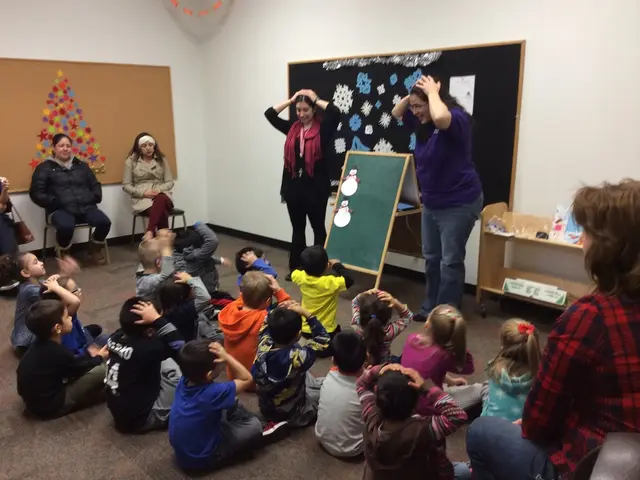Rising Use of AI-Generated Essays in College Applications Sparks Discussion on Repercussions and Morality Among Educators
In the realm of higher education, the use of Artificial Intelligence (AI) in college applications is becoming increasingly prevalent, raising concerns and questions among educators and students alike.
Valerio Capraro, a psychology professor at the University of Milan, has observed this trend, particularly in PhD application statements. Capraro encourages students to view AI as a tool to aid, not replace, their writing. He advises focusing on the content of the submission, rather than the form, just as one would with any other material.
Detecting AI-Generated Content
The detection of AI-generated content in college applications is a complex task that requires a combination of technology, human judgment, and clear institutional policies.
Colleges increasingly rely on AI content detectors such as Turnitin’s AI detection tool, GPTZero, Originality.AI, Copyleaks, and Scribbr. These tools analyze writing patterns at the sentence level to flag probable AI-generated text, although none are foolproof. Some tools can be bypassed by rewriting software, making them more of aids than definitive proof.
Human evaluation plays a crucial role in this process. Studies show that experienced college professors often detect AI-generated essays by noting a lack of human-like engagement features such as personal asides, rhetorical questions, and persuasive language. AI-written texts tend to be grammatically correct but feel less conversational or compelling compared to genuine student work.
Tools like Turnitin have embedded AI detection within learning management systems (LMS), allowing educators to screen submissions seamlessly alongside plagiarism checks.
Institutional Policies and Responses
Most U.S. colleges do not yet have uniform AI policies. Some, like Brown and USC, ban AI-generated writing completely in applications, while others (Caltech, Cornell, and the University of California system) allow limited AI use for brainstorming or grammar checking but forbid AI drafting or heavy rewriting.
Because policies vary and few detailed rules exist, colleges often handle AI use under general academic integrity frameworks, emphasizing honesty and originality. Institutions encourage transparency and responsible AI use, recognizing that AI can aid some writing tasks ethically but should not replace the applicant’s authentic voice.
In cases of detected AI use, admissions officers may question applicants about their essays to verify authenticity, asking for drafts or explanations of ideas expressed. Some colleges provide guidelines to applicants on permissible AI use and emphasize the value of personal insight over polished prose. In cases of unauthorized AI use, institutions may adopt penalties consistent with academic misconduct policies, ranging from warnings to application rejection depending on the severity.
The Role of AI in Writing Education
Capraro believes that teaching writing with AI should not replace thinking. He offers four tips for doing so effectively:
- Encourage creativity and critical thinking.
- Teach students to identify AI-generated writing features.
- Foster a culture of honesty and originality.
- Guide students in using AI responsibly and ethically.
Recently, Capraro posted about a specific application he received that appeared to be AI-generated, which unexpectedly went viral. This incident highlights the increase in AI-generated college submissions and the challenges faced by those reading these submissions.
The Future of AI in College Applications
The use of AI in college applications is a rapidly evolving field. Existing AI detection tools are flawed, and there is no consensus on how best to respond to AI-generated content. Some educators question why preventing students from using AI-generated application materials is a problem, while others believe that over-reliance on AI could lead to average jobs.
Jeffrey Hancock, a communications professor at Stanford University, suggests using AI to generate essays for college applications by custom training a tool like ChatGPT on a mix of good and bad college essays. His strategy involves the AI emulating good essays and avoiding patterns in bad ones.
The Common App, used by over 1 million students annually, has a policy against AI use, and students must agree to the app’s terms of service and sign an affirmation that what they submit is their own work. Much of the vetting process for AI-generated content is left to the higher education institutions themselves.
In summary, the best current practice blends AI detection technology with faculty expertise and clear ethical guidelines to identify and respond to AI-generated content in college applications. Transparency about AI use, faculty training to recognize AI writing features, and coherent institutional policies are key to managing this evolving challenge responsibly.
- College professors, like Valerio Capraro, advise students to use Artificial Intelligence (AI) as a tool to aid, not replace, their writing in college applications.
- The detection of AI-generated content in college applications is a complex task that relies on a combination of technology, human judgment, and clear institutional policies.
- Teaching students how to identify AI-generated writing features and using AI responsibly and ethically is an essential part of writing education.
- In the future, AI could potentially generate essays for college applications, but clear ethical guidelines, transparency, and faculty training are crucial to managing this evolving challenge responsibly.




